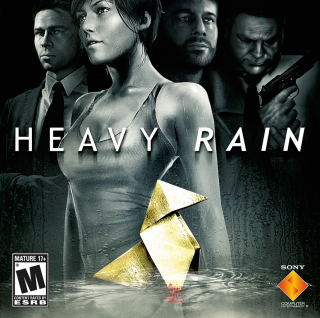
(originally posted at my blog, Properly Calibrated)
Rotate The Right Analog Stick 90º To Interact
I finished Mass Effect 2 yesterday — it took me about 30 hours. I just played the Heavy Rain demo, and that took me maybe 20 minutes. Let’s talk about Heavy Rain.
Heavy Rain, if you’re not aware, is an upcoming adventure(ish) game made by a studio named Quantic Dream (coolest name ever) and headed by Quantic Dream CEO David Cage (also coolest name ever). It is a very expensive game with very high-quality visuals.
Heavy Rain is an interesting new take on the intention of a Video Game User Interface.
The UI book that I was just reading this evening (timely!) explains that an interface is anything that separates the user from the data.
Here’s what that means: UI is the separation. It stands between a user and the information they are trying to access, the communication they are trying to send out, or the activity they are trying to accomplish.
Traditionally, UI is at its best when you don’t think about it being there. This is called a “clean” or “intuitive” UI by folks who think about such things — but most users call it nothing, because they accomplished what they intended to accomplish when they [started your application][visited your website][played your game] without ever having to stop and think about how they were doing so.

Heavy Rain is a crime drama. Its environments are highly, highly polished, with rain splashing convincingly off of windshields and characters approaching Final Fantasy Movie levels of photorealism. The story (at least from the hints in the demo) appears to be a potentially serpentine beauty, branching into dozens of different outcomes and possibilities.
Heavy Rain is also a world full of prompts. Playstation Button Symbols (X, Square, Circle, Triangle) float near character’s hands whenever contextually appropriate actions are possible.
Get in your car, and see an icon (see above graphic for the essential glossary of what prompt symbols mean) that explains that you must push the right analog stick to the right and a quarter-turn up in order for your character to insert his keys into the ignition and start the car. In another scene, push the right analog stick right and a quarter-turn up to put on your character’s sunglasses, right and a quarter-turn down to remove them. Hold buttons in the correct order to climb a muddy slope — miss one, and be rewarded with an animation of your character sliding roughly to the bottom of the slope. Miss again, and see the same animation.
In fight scenes, the prompts become timing-based — miss a prompt and your character fails to dodge a punch, or gets thrown through a window. It’s in these timing-based moments that the Heavy Rain control system shines. You’re watching a cinematic fight scene, yet influencing it!
However, the prompts themselves throw the disconnect between what you are doing and what you are seeing into stark relief. Pressing “B” in Mass Effect 2 on the XBox 360 causes your character to punch someone, but that interaction is only visualized on-screen by your character delivering said punch. Your mind is not thinking “B”, your mind is thinking “punch that guy”. UI is at its best when you don’t think about it being there.
In Heavy Rain, the button symbol floats on-screen with the character. Every scene is imprinted — some might say sullied — with button or action symbols. In almost all games, the UI facilitates the game, but in Heavy Rain, the UI becomes the game. Heavy Rain is a game where you play the user interface.
Regardless of my initial impressions, Heavy Rain is also a fantastic example of how fascinating this period in Video Games’ history continues to be. Like the early decades of film, which ranged from bizarre experiments to simple 3-wall-room plays filmed by a fixed camera, video games continue to reach out in various directions, struggling to define their native language in terms of visuals, storytelling, and interfaces. I respect Heavy Rain for reaching out in a new direction, but I’m afraid that direction may be disappointingly counterproductive.

Log in to comment